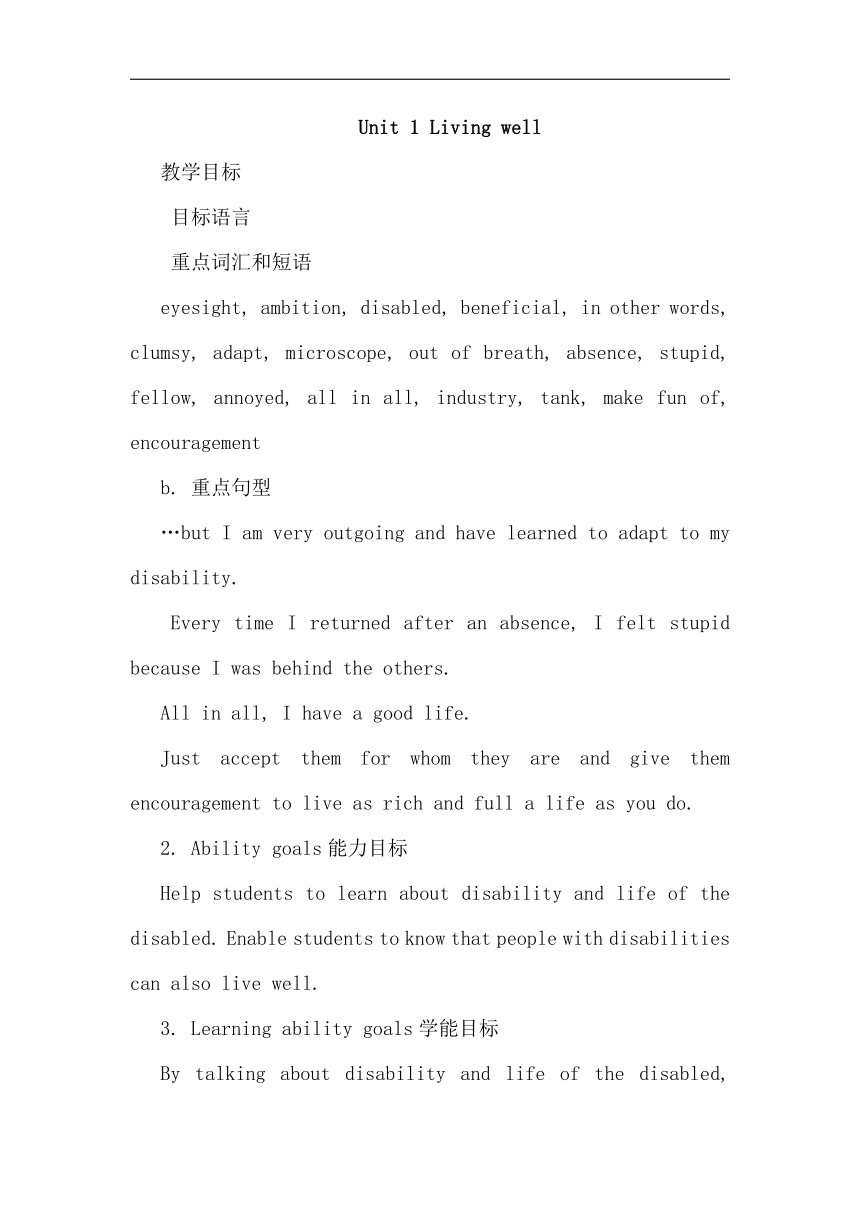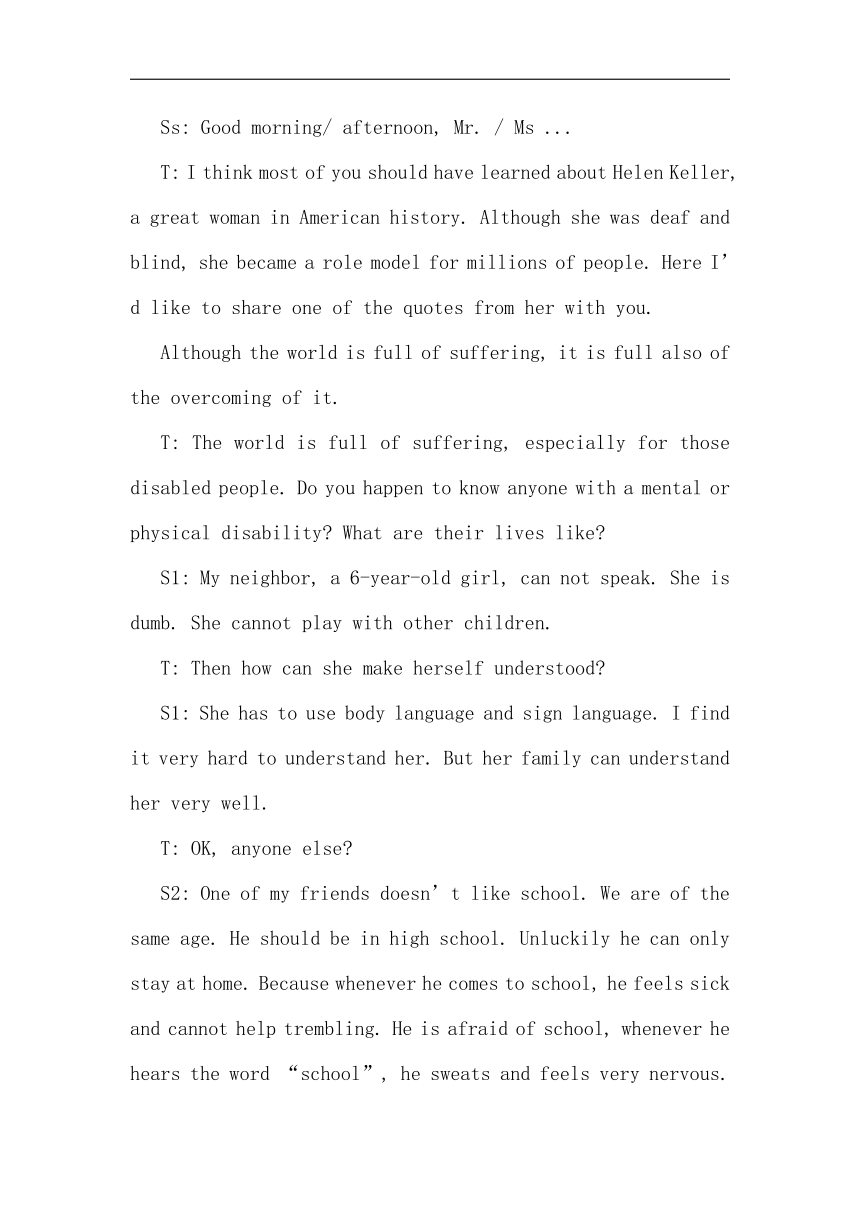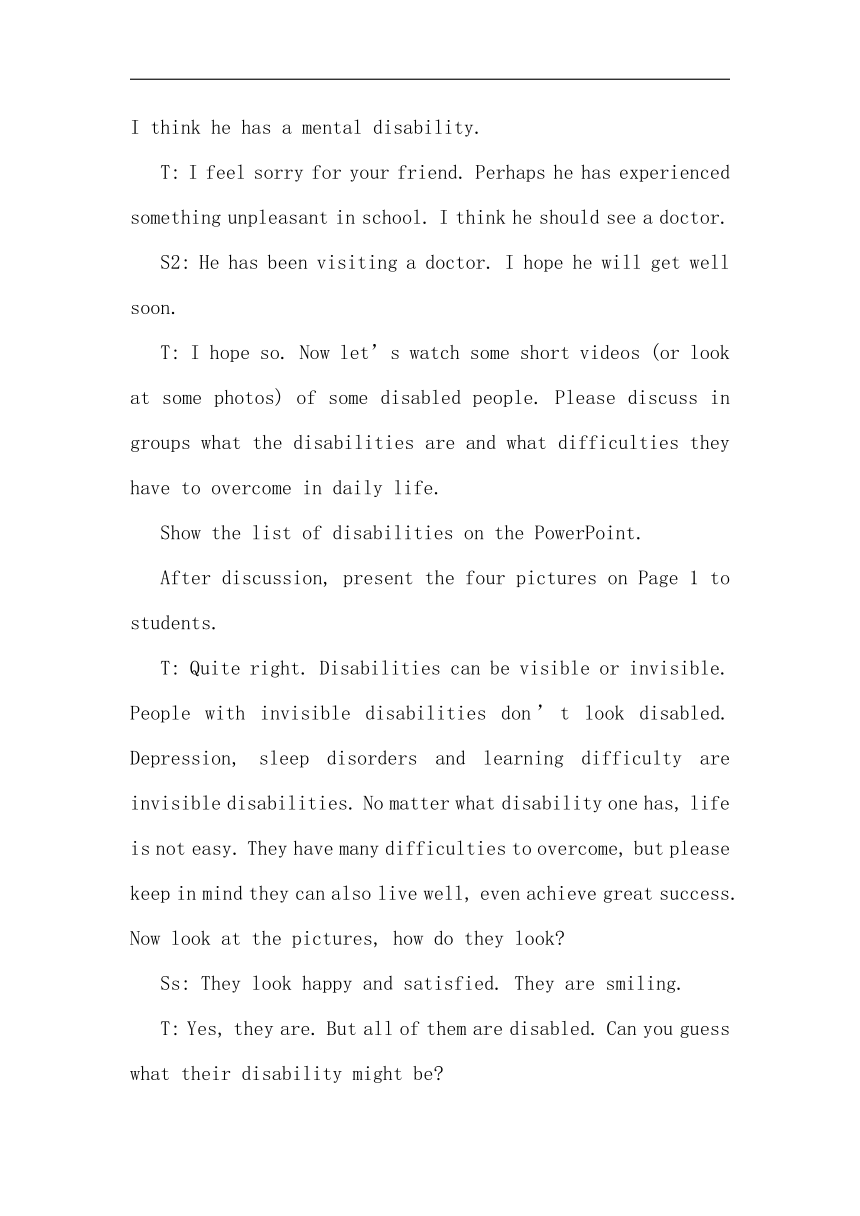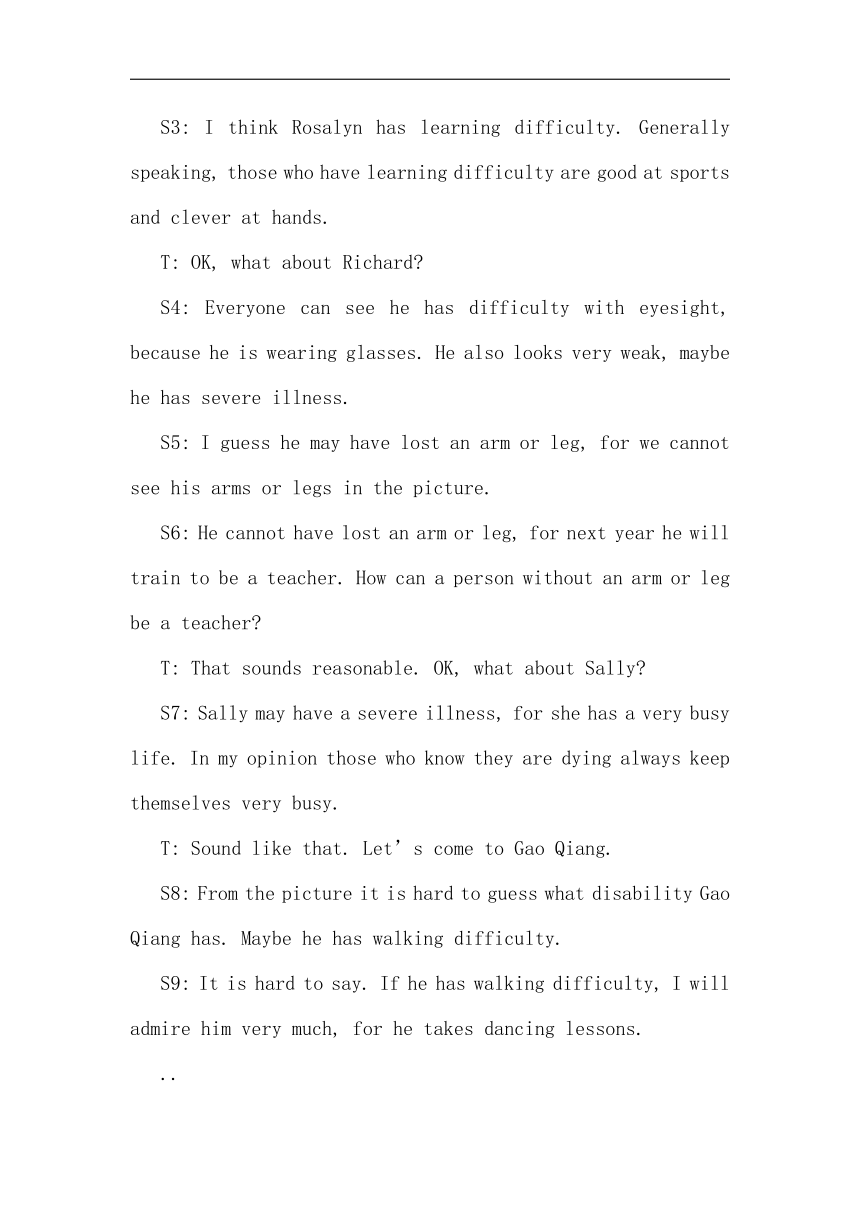人教版高中英语选修七Unit 1 Living well 教案
文档属性
| 名称 | 人教版高中英语选修七Unit 1 Living well 教案 |  | |
| 格式 | zip | ||
| 文件大小 | 15.3KB | ||
| 资源类型 | 教案 | ||
| 版本资源 | 人教版(新课程标准) | ||
| 科目 | 英语 | ||
| 更新时间 | 2019-09-06 10:10:17 | ||
图片预览





文档简介
Unit 1 Living well
教学目标
目标语言
重点词汇和短语
eyesight, ambition, disabled, beneficial, in other words, clumsy, adapt, microscope, out of breath, absence, stupid, fellow, annoyed, all in all, industry, tank, make fun of, encouragement
b. 重点句型
…but I am very outgoing and have learned to adapt to my disability.
Every time I returned after an absence, I felt stupid because I was behind the others.
All in all, I have a good life.
Just accept them for whom they are and give them encouragement to live as rich and full a life as you do.
2. Ability goals能力目标
Help students to learn about disability and life of the disabled. Enable students to know that people with disabilities can also live well.
3. Learning ability goals学能目标
By talking about disability and life of the disabled, students will learn some positive stories of the disabled. This will help them understand more about how challenging life can be for the disabled.
Teaching important points教学重点
How positive stories of the people with disabilities inspire others.
Teaching difficult points 教学难点
How to help students understand the difficulties the disabled have to overcome.
Teaching methods教学方法
Discussing, explaining, reading and practicing.
Teaching aids教具准备
Multi-media computer.
Teaching procedures && ways教学过程与方式
Step I Lead-in
Deal with Warming Up. First ask students to talk about people with a mental or physical disability to see how much they know about disabilities. Then play some videos or show some photos of people with disabilities. Students will be asked to discuss what the disabilities are and what difficulties they have to overcome in daily life.
T: Good morning /afternoon, class!
Ss: Good morning/ afternoon, Mr. / Ms ...
T: I think most of you should have learned about Helen Keller, a great woman in American history. Although she was deaf and blind, she became a role model for millions of people. Here I’d like to share one of the quotes from her with you.
Although the world is full of suffering, it is full also of the overcoming of it.
T: The world is full of suffering, especially for those disabled people. Do you happen to know anyone with a mental or physical disability? What are their lives like?
S1: My neighbor, a 6-year-old girl, can not speak. She is dumb. She cannot play with other children.
T: Then how can she make herself understood?
S1: She has to use body language and sign language. I find it very hard to understand her. But her family can understand her very well.
T: OK, anyone else?
S2: One of my friends doesn’t like school. We are of the same age. He should be in high school. Unluckily he can only stay at home. Because whenever he comes to school, he feels sick and cannot help trembling. He is afraid of school, whenever he hears the word “school”, he sweats and feels very nervous. I think he has a mental disability.
T: I feel sorry for your friend. Perhaps he has experienced something unpleasant in school. I think he should see a doctor.
S2: He has been visiting a doctor. I hope he will get well soon.
T: I hope so. Now let’s watch some short videos (or look at some photos) of some disabled people. Please discuss in groups what the disabilities are and what difficulties they have to overcome in daily life.
Show the list of disabilities on the PowerPoint.
After discussion, present the four pictures on Page 1 to students.
T: Quite right. Disabilities can be visible or invisible. People with invisible disabilities don’t look disabled. Depression, sleep disorders and learning difficulty are invisible disabilities. No matter what disability one has, life is not easy. They have many difficulties to overcome, but please keep in mind they can also live well, even achieve great success. Now look at the pictures, how do they look?
Ss: They look happy and satisfied. They are smiling.
T: Yes, they are. But all of them are disabled. Can you guess what their disability might be?
S3: I think Rosalyn has learning difficulty. Generally speaking, those who have learning difficulty are good at sports and clever at hands.
T: OK, what about Richard?
S4: Everyone can see he has difficulty with eyesight, because he is wearing glasses. He also looks very weak, maybe he has severe illness.
S5: I guess he may have lost an arm or leg, for we cannot see his arms or legs in the picture.
S6: He cannot have lost an arm or leg, for next year he will train to be a teacher. How can a person without an arm or leg be a teacher?
T: That sounds reasonable. OK, what about Sally?
S7: Sally may have a severe illness, for she has a very busy life. In my opinion those who know they are dying always keep themselves very busy.
T: Sound like that. Let’s come to Gao Qiang.
S8: From the picture it is hard to guess what disability Gao Qiang has. Maybe he has walking difficulty.
S9: It is hard to say. If he has walking difficulty, I will admire him very much, for he takes dancing lessons.
..
T: OK, please remember there are many disabled people in the world. They are part of the world. They also have rights to enjoy life. Would you like to learn more about them and try to do something for them? Here is a website “Family village”. From here we can learn some positive stories about the disabled.
Step Ⅱ Pre-reading
Ask students to read the passage about “Family village” in pre-reading carefully and find out the purpose of the website. Then show the suggested answers on the PowerPoint.
Suggested answers:
1. To give ordinary young people with a disability the chance to share their stories with others.
2. To inspire other disabled people.
3. To get non-disabled people to understand more about how challenging life can be for people with disabilities.
Step Ⅲ Reading
Deal with the reading passage.
Scanning
Ask students to scan the text and find problems Marty has in his life and what he does in spite of his disability.
T: First I’d like you to do scanning and then fill in the chart with the information you get from the text. After you have finished, please compare your answer with your partner’s.
Several minutes later, students compare their information with each other in groups. Then check the answer with the whole class.
T: From this chart we can have a clear image of Marty. What kind of person is Marty? You may discuss in groups. You may refer to the adjectives on the PowerPoint.
Show some adjectives on the PowerPoint.
brave, unlucky, weak, clumsy, strong-minded, optimistic, happy, independent, stupid
T: OK. You are right. Though Marty has a muscle disease which causes many difficulties to his life, he still lives well. He is living a busy and satisfying life. He is very optimistic.
Then continue to discuss the next questions on Page 3. Deal with the next questions in the same way.
Suggested answers:
1. Marty seems to be a fairly positive person who considers he has a good life. He is realistic about his disability, but does not let this stop him doing as much as he can. He is a psychologically strong, independent boy.
2. Missing lots of school, not being able to run around and play sports like other boys at his age, people not understanding that he has a disability.
3. Marty keeps busy doing things that do not require physical strength, like computer programming. He has friends with whom he can go to movies and football matches and he has lots of pets. He also studies hard.
4. They can accept people with disabilities like Marty for who they are rather than focus on their disability. They can encourage them to live rich and full lives.
5. Because they found that Marty was able to live as rich and full a life as everyone else.
6. Answers would vary.
Careful reading
Ask students to read the text carefully and then finish Ex3 on Page 4.
T: Now let’s read the text again and try to sum up the main idea of each paragraph.
Several minutes later check the answers with the whole class.
Suggested answers:
Paragraph 1: An introduction to Marty and his muscle disease
Paragraph 2: How his disability developed
Paragraph 3: Marty met a lot of difficulties at school
Paragraph 4: How his life has become easier
Paragraph 5: The advantages of his disease
Summary
Ask students to work together to write a mini biography for Marty according to the text.
T: Now we’ve finished Marty’s story. Now it’s time for you to work in groups and write a mini biography for him.
My mini bio
Name:
Status:
Health:
Interests and Hobbies:
Ambition:
Motto:
A few minutes later show the sample on the PowerPoint.
My mini bio
Name: Marty Fielding
Status: High school student
Health: developed a muscle disease at the age about 10, very weak, cannot do things like normal people
Interests and Hobbies:
· Enjoying writing and computer programming
· Going to the movies and football matches when I am well enough
· Spending a lot of time with my pets—two rabbits, five mice, a tank full of fish and a snake
Ambition: to work in the computer industry
Motto: live one day at a time
Explanation
During this procedure, play the tape for students. Students will underline the difficult sentences. After listening to the tape, explain the text and deal with the language problems.
T: Now we will deal with some difficult language points. I will play the recording of the text for you. Please make a mark where you have difficulties.
After listening to the tape, explain the difficult sentences to students. Before explaining the difficult points, students are asked to refer to the notes to the text on Pages 86-87.
T: Do you have any difficulties with the text?
S1: Could you please explain the sentence to us:
I have learned to adapt to my disability.
T: Before he developed the disease, he could run or climb the stairs as quickly as other people. But after he had the disease, he becomes very weak, so he cannot run very fast. It takes time for him to get used to slow pace. Besides this the disease has brought many other difficulties to him, he has to get used to living with the disease. So we can understand it like this: I have got used to living with the disease. Do you have any other questions?
Ss: No.
T: This is a very inspiring story. From Marty’s story, what have you learned?
S1: We should be patient with people with disabilities. We shouldn’t get annoyed just because they are slow.
S2: We shouldn’t feel sorry for them. That might hurt them.
S3: We should help them in a clever way.
S4: We should encourage them when they feel down.
...
S8: Just having a disability doesn’t mean your life is not satisfying.
T: I’m very glad all of you have learned something from the story. Please remember everyone can live well even if he has a disability. If you’d like to learn more about the life of disabled people, please surf the Internet.
Step Ⅳ Homework
Retell Marty’s story according to the mini bio.
Surf the Internet to learn more about the life of disabled people.
教学目标
目标语言
重点词汇和短语
eyesight, ambition, disabled, beneficial, in other words, clumsy, adapt, microscope, out of breath, absence, stupid, fellow, annoyed, all in all, industry, tank, make fun of, encouragement
b. 重点句型
…but I am very outgoing and have learned to adapt to my disability.
Every time I returned after an absence, I felt stupid because I was behind the others.
All in all, I have a good life.
Just accept them for whom they are and give them encouragement to live as rich and full a life as you do.
2. Ability goals能力目标
Help students to learn about disability and life of the disabled. Enable students to know that people with disabilities can also live well.
3. Learning ability goals学能目标
By talking about disability and life of the disabled, students will learn some positive stories of the disabled. This will help them understand more about how challenging life can be for the disabled.
Teaching important points教学重点
How positive stories of the people with disabilities inspire others.
Teaching difficult points 教学难点
How to help students understand the difficulties the disabled have to overcome.
Teaching methods教学方法
Discussing, explaining, reading and practicing.
Teaching aids教具准备
Multi-media computer.
Teaching procedures && ways教学过程与方式
Step I Lead-in
Deal with Warming Up. First ask students to talk about people with a mental or physical disability to see how much they know about disabilities. Then play some videos or show some photos of people with disabilities. Students will be asked to discuss what the disabilities are and what difficulties they have to overcome in daily life.
T: Good morning /afternoon, class!
Ss: Good morning/ afternoon, Mr. / Ms ...
T: I think most of you should have learned about Helen Keller, a great woman in American history. Although she was deaf and blind, she became a role model for millions of people. Here I’d like to share one of the quotes from her with you.
Although the world is full of suffering, it is full also of the overcoming of it.
T: The world is full of suffering, especially for those disabled people. Do you happen to know anyone with a mental or physical disability? What are their lives like?
S1: My neighbor, a 6-year-old girl, can not speak. She is dumb. She cannot play with other children.
T: Then how can she make herself understood?
S1: She has to use body language and sign language. I find it very hard to understand her. But her family can understand her very well.
T: OK, anyone else?
S2: One of my friends doesn’t like school. We are of the same age. He should be in high school. Unluckily he can only stay at home. Because whenever he comes to school, he feels sick and cannot help trembling. He is afraid of school, whenever he hears the word “school”, he sweats and feels very nervous. I think he has a mental disability.
T: I feel sorry for your friend. Perhaps he has experienced something unpleasant in school. I think he should see a doctor.
S2: He has been visiting a doctor. I hope he will get well soon.
T: I hope so. Now let’s watch some short videos (or look at some photos) of some disabled people. Please discuss in groups what the disabilities are and what difficulties they have to overcome in daily life.
Show the list of disabilities on the PowerPoint.
After discussion, present the four pictures on Page 1 to students.
T: Quite right. Disabilities can be visible or invisible. People with invisible disabilities don’t look disabled. Depression, sleep disorders and learning difficulty are invisible disabilities. No matter what disability one has, life is not easy. They have many difficulties to overcome, but please keep in mind they can also live well, even achieve great success. Now look at the pictures, how do they look?
Ss: They look happy and satisfied. They are smiling.
T: Yes, they are. But all of them are disabled. Can you guess what their disability might be?
S3: I think Rosalyn has learning difficulty. Generally speaking, those who have learning difficulty are good at sports and clever at hands.
T: OK, what about Richard?
S4: Everyone can see he has difficulty with eyesight, because he is wearing glasses. He also looks very weak, maybe he has severe illness.
S5: I guess he may have lost an arm or leg, for we cannot see his arms or legs in the picture.
S6: He cannot have lost an arm or leg, for next year he will train to be a teacher. How can a person without an arm or leg be a teacher?
T: That sounds reasonable. OK, what about Sally?
S7: Sally may have a severe illness, for she has a very busy life. In my opinion those who know they are dying always keep themselves very busy.
T: Sound like that. Let’s come to Gao Qiang.
S8: From the picture it is hard to guess what disability Gao Qiang has. Maybe he has walking difficulty.
S9: It is hard to say. If he has walking difficulty, I will admire him very much, for he takes dancing lessons.
..
T: OK, please remember there are many disabled people in the world. They are part of the world. They also have rights to enjoy life. Would you like to learn more about them and try to do something for them? Here is a website “Family village”. From here we can learn some positive stories about the disabled.
Step Ⅱ Pre-reading
Ask students to read the passage about “Family village” in pre-reading carefully and find out the purpose of the website. Then show the suggested answers on the PowerPoint.
Suggested answers:
1. To give ordinary young people with a disability the chance to share their stories with others.
2. To inspire other disabled people.
3. To get non-disabled people to understand more about how challenging life can be for people with disabilities.
Step Ⅲ Reading
Deal with the reading passage.
Scanning
Ask students to scan the text and find problems Marty has in his life and what he does in spite of his disability.
T: First I’d like you to do scanning and then fill in the chart with the information you get from the text. After you have finished, please compare your answer with your partner’s.
Several minutes later, students compare their information with each other in groups. Then check the answer with the whole class.
T: From this chart we can have a clear image of Marty. What kind of person is Marty? You may discuss in groups. You may refer to the adjectives on the PowerPoint.
Show some adjectives on the PowerPoint.
brave, unlucky, weak, clumsy, strong-minded, optimistic, happy, independent, stupid
T: OK. You are right. Though Marty has a muscle disease which causes many difficulties to his life, he still lives well. He is living a busy and satisfying life. He is very optimistic.
Then continue to discuss the next questions on Page 3. Deal with the next questions in the same way.
Suggested answers:
1. Marty seems to be a fairly positive person who considers he has a good life. He is realistic about his disability, but does not let this stop him doing as much as he can. He is a psychologically strong, independent boy.
2. Missing lots of school, not being able to run around and play sports like other boys at his age, people not understanding that he has a disability.
3. Marty keeps busy doing things that do not require physical strength, like computer programming. He has friends with whom he can go to movies and football matches and he has lots of pets. He also studies hard.
4. They can accept people with disabilities like Marty for who they are rather than focus on their disability. They can encourage them to live rich and full lives.
5. Because they found that Marty was able to live as rich and full a life as everyone else.
6. Answers would vary.
Careful reading
Ask students to read the text carefully and then finish Ex3 on Page 4.
T: Now let’s read the text again and try to sum up the main idea of each paragraph.
Several minutes later check the answers with the whole class.
Suggested answers:
Paragraph 1: An introduction to Marty and his muscle disease
Paragraph 2: How his disability developed
Paragraph 3: Marty met a lot of difficulties at school
Paragraph 4: How his life has become easier
Paragraph 5: The advantages of his disease
Summary
Ask students to work together to write a mini biography for Marty according to the text.
T: Now we’ve finished Marty’s story. Now it’s time for you to work in groups and write a mini biography for him.
My mini bio
Name:
Status:
Health:
Interests and Hobbies:
Ambition:
Motto:
A few minutes later show the sample on the PowerPoint.
My mini bio
Name: Marty Fielding
Status: High school student
Health: developed a muscle disease at the age about 10, very weak, cannot do things like normal people
Interests and Hobbies:
· Enjoying writing and computer programming
· Going to the movies and football matches when I am well enough
· Spending a lot of time with my pets—two rabbits, five mice, a tank full of fish and a snake
Ambition: to work in the computer industry
Motto: live one day at a time
Explanation
During this procedure, play the tape for students. Students will underline the difficult sentences. After listening to the tape, explain the text and deal with the language problems.
T: Now we will deal with some difficult language points. I will play the recording of the text for you. Please make a mark where you have difficulties.
After listening to the tape, explain the difficult sentences to students. Before explaining the difficult points, students are asked to refer to the notes to the text on Pages 86-87.
T: Do you have any difficulties with the text?
S1: Could you please explain the sentence to us:
I have learned to adapt to my disability.
T: Before he developed the disease, he could run or climb the stairs as quickly as other people. But after he had the disease, he becomes very weak, so he cannot run very fast. It takes time for him to get used to slow pace. Besides this the disease has brought many other difficulties to him, he has to get used to living with the disease. So we can understand it like this: I have got used to living with the disease. Do you have any other questions?
Ss: No.
T: This is a very inspiring story. From Marty’s story, what have you learned?
S1: We should be patient with people with disabilities. We shouldn’t get annoyed just because they are slow.
S2: We shouldn’t feel sorry for them. That might hurt them.
S3: We should help them in a clever way.
S4: We should encourage them when they feel down.
...
S8: Just having a disability doesn’t mean your life is not satisfying.
T: I’m very glad all of you have learned something from the story. Please remember everyone can live well even if he has a disability. If you’d like to learn more about the life of disabled people, please surf the Internet.
Step Ⅳ Homework
Retell Marty’s story according to the mini bio.
Surf the Internet to learn more about the life of disabled people.
